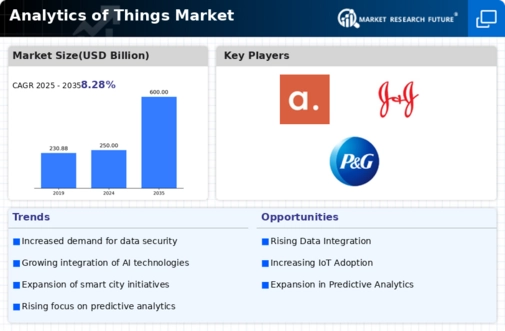The analytics of things market is characterized by a rapidly evolving competitive landscape, driven by advancements in data analytics, IoT integration, and the increasing demand for real-time insights across various sectors. Major players such as IBM (US), Microsoft (US), and Amazon (US) are strategically positioned to leverage their technological prowess and extensive resources. IBM (US) focuses on innovation through its Watson platform, which integrates AI and machine learning to enhance data analytics capabilities. Microsoft (US) emphasizes partnerships and cloud solutions, particularly through Azure, to facilitate seamless data integration and analytics for businesses. Amazon (US), with its robust cloud infrastructure, aims to democratize access to analytics tools, thereby expanding its market reach. Collectively, these strategies foster a competitive environment that prioritizes technological advancement and customer-centric solutions.
Key business tactics within the analytics of things market include localizing manufacturing and optimizing supply chains to enhance operational efficiency. The market structure appears moderately fragmented, with a mix of established players and emerging startups. The influence of key players is substantial, as they not only set industry standards but also drive innovation through competitive practices. This dynamic fosters an environment where agility and responsiveness to market demands are crucial for success.
In November 2025, IBM (US) announced a strategic partnership with a leading automotive manufacturer to develop advanced analytics solutions for predictive maintenance. This collaboration is poised to enhance operational efficiency and reduce downtime, showcasing IBM's commitment to integrating analytics into critical industry applications. The strategic importance of this partnership lies in its potential to position IBM as a leader in the automotive analytics sector, thereby expanding its market footprint.
In October 2025, Microsoft (US) launched a new suite of analytics tools designed specifically for small and medium-sized enterprises (SMEs). This initiative aims to empower SMEs with advanced data analytics capabilities, enabling them to make informed decisions based on real-time data. The significance of this launch is underscored by Microsoft's focus on inclusivity and accessibility, which could potentially reshape the competitive landscape by attracting a new customer base.
In September 2025, Amazon (US) unveiled enhancements to its AWS analytics services, incorporating machine learning algorithms to provide deeper insights into customer behavior. This move is strategically important as it not only strengthens Amazon's position in the cloud analytics market but also aligns with the growing trend of AI integration in business operations. By offering advanced analytics capabilities, Amazon is likely to attract more enterprises seeking to leverage data for competitive advantage.
As of December 2025, current competitive trends in the analytics of things market are heavily influenced by digitalization, sustainability, and AI integration. Strategic alliances among key players are shaping the landscape, fostering innovation and collaboration. The shift from price-based competition to a focus on technological differentiation and supply chain reliability is evident. Companies are increasingly prioritizing innovation and customer-centric solutions, suggesting that future competitive dynamics will hinge on the ability to deliver cutting-edge technology and reliable services.














Leave a Comment